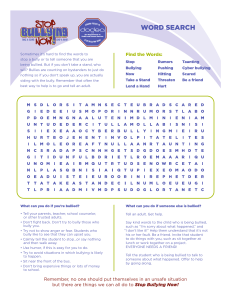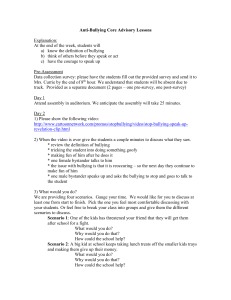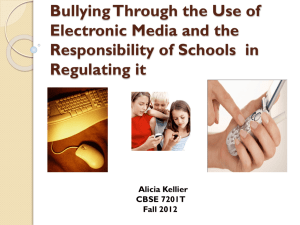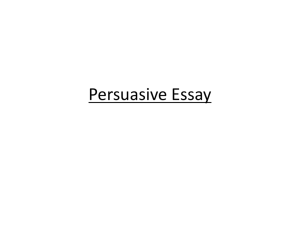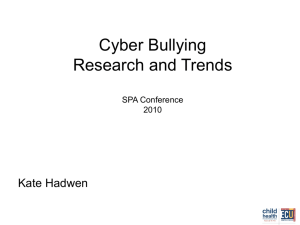Interpersonal Communication and addressing Bullying Behaviors
advertisement
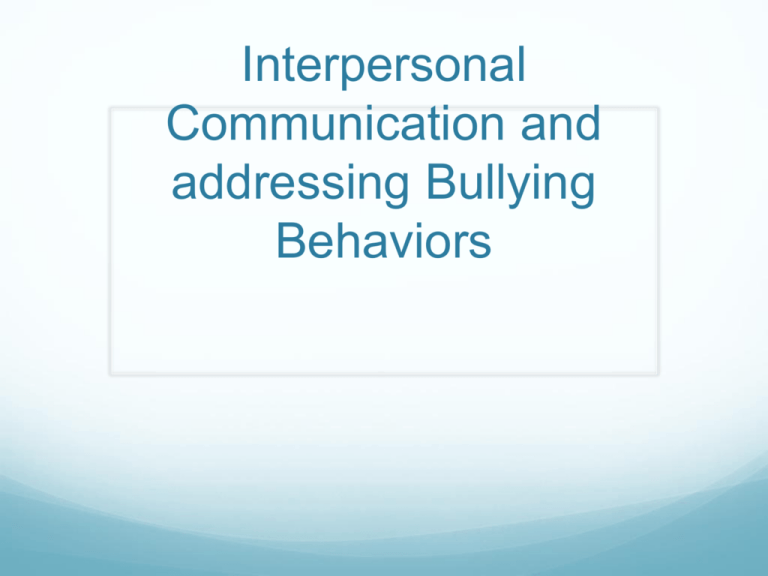
Interpersonal Communication and addressing Bullying Behaviors Warm up “Some people just want to watch the world burn” – Batman: The Dark Knight What does this mean to you, in reference to bullying and deviance? Vocabulary Words Loathe: (verb) to despise, strongly dislike, be unbearable Omnipresent: (adjective) to be everywhere “omni”=all around Propaganda: (noun) misinformation, rumors, slander spread about someone or something Interpersonal? Interpersonal communication: communication between 2 or more people or groups What are some general types of communication? Communication Types Verbal: Using written or spoken language Ex: Talking, newspaper, email, signs, (this Powerpoint),etc Nonverbal: Communicating without written or spoken language Ex: hand gestures, facial gestures, actions, pictures How might one message be conveyed using either verbal or nonverbal communication style? Bullying What is it? When does joking around become too much and therefore bullying? What are some common ways that people are bullied in the 21stcentury? Why Bully? People and children often “bully” or demean individuals due to insecurities. These insecurities can be for a variety of reasons Envy Anger Unsure of themselves Sad Feel threatened The need to feel better or stronger than someone else Other reasons Prevention of Bullying Avoid situations that foster negative interactions If someone seems to treat you poorly or not respect you, don’t continue to be around them Reframe from sharing information that might make you a target for bullying or make you look/sound bad Be yourself. Don’t try to what other people are or might want you to be Negative Intervention Strategies Confront them with a strong tone Challenge them to a fight or contest Spread rumors about them as revenge Tweet or post a Facebook message incriminating or embarrassing them Destructive behaviors Violence, drug use, reckless acts, vandalism, even suicide, etc Avoid these!!!! Positive Intervention of Bullying If you are being bullied or someone you know is bullied, what can they/you do? Talk to an authority figure about the issue Ex: • • • • Teacher Counselor Parent Coach Adults can wield stronger change than students or children can Tattling vs Telling What is the difference? Sometimes hard to discern the difference Tattling: negative connotation • Usually having to do with sharing small wrong doings • Usually for issues that can be controlled Telling: positive connotation • Usually reporting a serious issue • Giving details of ongoing problem Cyber Bullying Big problem in the world, especially in the US What is it? When using blogs or social media, be extremely careful about what you are posting or sharing. Also be very careful who you share things with or who can see your information Ex: Facebook settings; only allow people you trust and want to share with, see and be able to post on your site Cyber Bullying (continued) Once you put something on the Internet, it is global property Once you click “post” or “send” it cannot be undone If someone is teasing you or spreading bad things about you on the Internet things you can do: Many websites have a “report” option where you can tell the manager about the issue and have the person removed or item removed Close out your account to remove direct threat or access




